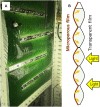Effect of Membrane Hydrophobicity and Thickness on Energy-Efficient Dissolved Oxygen Removal From Algal Culture
- PMID: 32974310
- PMCID: PMC7471630
- DOI: 10.3389/fbioe.2020.00978
Effect of Membrane Hydrophobicity and Thickness on Energy-Efficient Dissolved Oxygen Removal From Algal Culture
Abstract
Removal of dissolved oxygen from algal photobioreactors is essential for high productivity in mass cultivation. Gas-permeating photobioreactor that uses hydrophobic membranes to permeate dissolved oxygen (pervaporation) from its body itself is an energy-efficient option for oxygen removal. This study comparably evaluated the characteristics of various commercial membranes and determined the criteria for the selection of suitable ones for the gas-permeating photobioreactors. It was found that oxygen permeability is limited not by that in the membrane but in the liquid boundary layer. Membrane thickness had a negative effect on membrane oxygen permeability, but the effect was as minor as less than 3% compared with the liquid boundary layer. Due to this characteristic, the lamination of non-woven fabric with the microporous film did not significantly decrease the overall oxygen transfer coefficient. The permeability in the liquid boundary layer had a significantly positive relationship with the hydrophobicity. The highest overall oxygen transfer coefficients in the water-to-air and water-to-water oxygen removal tests were 2.1 ± 0.03 × 10-5 and 1.39 ± 0.09 × 10-5 m s-1, respectively. These values were considered effective in the dissolved oxygen removal from high-density algal culture to prevent oxygen inhibition. Furthermore, hydrophobicity was found to have a significant relationship also with water entry pressure, which needs to be high to avoid culture liquid leakage. Therefore, these results suggested that a microporous membrane with strong hydrophobicity laminated with non-woven fabric would be suitable characteristics for gas-permeating photobioreactor.
Keywords: dissolved oxygen; gas-permeating; hydrophobicity; microporous membrane; pervaporation; thickness.
Copyright © 2020 Kishi, Nagatsuka and Toda.
Figures









References
-
- Abomohra A. E. F., El-Sheekh M., Hanelt D. (2014). Pilot cultivation of the chlorophyte microalga Scenedesmus obliquus as a promising feedstock for biofuel. Biomass Bioenergy 64 237–244. 10.1016/j.biombioe.2014.03.049 - DOI
-
- Bazhenov S. D., Bildyukevich A. V., Volkov A. V. (2018). Gas-liquid hollow fiber membrane contactors for different applications. Fibers 6:76 10.3390/fib6040076 - DOI
-
- Bhaumik D., Majumdar S., Fan Q., Sirkar K. K. (2004). Hollow fiber membrane degassing in ultrapure water and microbiocontamination. J. Memb. Sci. 235 31–41. 10.1016/j.memsci.2003.12.022 - DOI
-
- Brüschke H. E. A. (1990). Removal of ethanol from aqueous streams by pervaporation. Desalination 77 323–330. 10.1016/0011-9164(90)85032-6 - DOI
LinkOut - more resources
Full Text Sources

